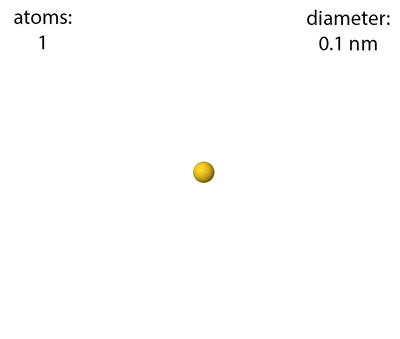I was talking to my mom the other day, about nanoparticles of course, and she said: “Wait a second! Are there different sizes of nanoparticles?? I thought nano was just nano! You know?”
Thanks for the question mom! 🙂

Refresher: nanoparticles are just spherical or nearly-spherical nanomaterials.
To answer my mom’s question: There are LOTS of different sizes of nanoparticles. Here is an animation I made showing 8 nanoparticles of different sizes—starting with a single atom just for comparison.

“Why did my Mom have that impression?”, I wondered.
After some pondering I realized that people like me are always saying things like, “nanoparticles are 10,000 times smaller than the width of a human hair!!!!” BUT, that statement can be pretty misleading, because they can also be 1,000 times smaller, or 5,000 times smaller, or 20,000 times smaller, etc. etc. The 10,000 number is just a convenient “average” people use.
Technically nanomaterials must have one dimension smaller than 100 nanometers, which is 50 times larger than the largest nanoparticle in the above animation! Depending on your screen resolution, that giant nanoparticle would be about 10 feet across!!! And in the space between the tiniest nanoparticle in that animation and the ten foot giant nanoparticle, there are countless different sizes! Imagine it!!!

So, nanomaterials can come in all different sizes! But don’t get overwhelmed yet, because I haven’t even mentioned how they can come in different shapes and be made of different stuff. Nanomaterials are SO DIVERSE.

Dr. Bishop, I was quite surprised to discover that you have a Ph.D. in chemistry due to your poor ability to communicate scientific information to the general public. I hope that if you are continuing with scientific endeavores that you take more care in your work to important details than you have in this blog.
You state, “Refresher: nanoparticles are just spherical or nearly-spherical nanomaterials.” Then later you state, “… I haven’t even mentioned how they can come in different shapes…”.
Of course, because the second statement is correct, the first statement cannot be correct. However, for shapes other than spheroidal, we typically use a more descriptive term such as “nanotube”, nanorod”, “nanosheet”, “nanoribbon”, etc., realizing that ALL of these non-spheroidal shapes are still “nanoparticles”.
You also state, “…nanomaterials must have one dimension smaller than 100 nanometers…”. This also is not accurate. The ASTM E2456-06 standard requires lengths in 2 or 3 dimensions (not 1 or more) of 1-100 nm.
Dr. Dave, Ph.D. applied chemistry, researcher in nanochemistry and technology
Hi Dr. Dave. Thank you for sharing your definitions with us. You raise an interesting point, that various organizations and groups of scientists define nanoparticle and nanomaterial in different ways. You might be interested in this book chapter: http://www.wiley-vch.de/books/sample/3527331972_c01.pdf The ASTM does indeed require length in 2 or 3 dimensions to be between 1-100 nm, but that is not the case with all organizations. See also: http://ec.europa.eu/environment/chemicals/nanotech/faq/definition_en.htm
Among the researchers I work with, we use “nanoparticle” to refer to spherical or nearly spherical nanoscale objects and “nanomaterial” to refer to nanoscale objects of any shape (nanotube, nanorod, nanosheet, etc). It’s really interesting you raise this, as it seem to me to be a feature of how relatively young the field of nanotechnology is. If you feel differently I welcome your input.
I am also a bit surprised that you believe all PhD scientists are experts at communicating with the general public. I have found it to be quite the opposite. Most PhD scientists I have encountered, after their years of training, tend to have quite a bit of difficulty really truly communicating information to members of the public. That is one thing we strive to do here with this blog, is provide the scientists in our Center with the training they need to communicate more effectively with non-technically trained audiences.
I also appreciate your pointing out the contradiction I used in the blog post above. If nanoparticles are spherical they of course cannot come in different shapes. I will of course leave this thread up as evidence of how the post used to read, but will amend the post accordingly. Thank you.
I would also just like to point out that in the body of the text of this post I avoided an intense discussion of these definitions as I’ve found that non-technically trained (and even many technically trained) readers will lose interest after even one or two sentences of definitions. We strive here to keep our readers engaged.
Thanks again for visiting and sharing your insights.
Actually in taking another look at the language I used above, I was careful to use the terms “nanoparticle” and “nanomaterial” according to the definitions I outlined in my reply above, so I did not change anything.
Thanks again for visiting!